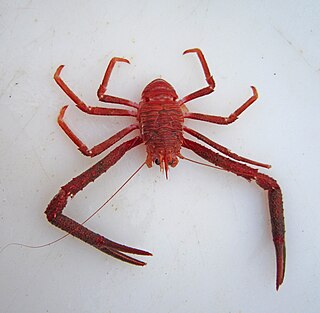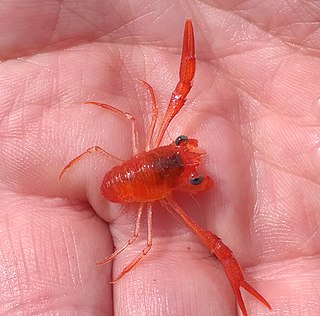
The Fabaceae or Leguminosae, commonly known as the legume, pea, or bean family, are a large and agriculturally important family of flowering plants. It includes trees, shrubs, and perennial or annual herbaceous plants, which are easily recognized by their fruit (legume) and their compound, stipulate leaves. The family is widely distributed, and is the third-largest land plant family in number of species, behind only the Orchidaceae and Asteraceae, with about 765 genera and nearly 20,000 known species.

Squat lobsters are dorsoventrally flattened crustaceans with long tails held curled beneath the cephalothorax. They are found in the two superfamilies Galatheoidea and Chirostyloidea, which form part of the decapod infraorder Anomura, alongside groups including the hermit crabs and mole crabs. They are distributed worldwide in the oceans, and occur from near the surface to deep sea hydrothermal vents, with one species occupying caves above sea level. More than 900 species have been described, in around 60 genera. Some species form dense aggregations, either on the sea floor or in the water column, and a small number are commercially fished.

Acacia pycnantha, most commonly known as the golden wattle, is a tree of the family Fabaceae native to southeastern Australia. It grows to a height of 8 m (26 ft) and has phyllodes instead of true leaves. Sickle-shaped, these are between 9 and 15 cm long, and 1–3.5 cm wide. The profuse fragrant, golden flowers appear in late winter and spring, followed by long seed pods. Plants are cross-pollinated by several species of honeyeater and thornbill, which visit nectaries on the phyllodes and brush against flowers, transferring pollen between them. An understorey plant in eucalyptus forest, it is found from southern New South Wales and the Australian Capital Territory, through Victoria and into southeastern South Australia.

Acacia, commonly known as the wattles or acacias, is a large genus of shrubs and trees in the subfamily Mimosoideae of the pea family Fabaceae. Initially, it comprised a group of plant species native to Africa and Australasia, but it has now been limited to contain only the Australasian species. The genus name is New Latin, borrowed from the Greek ἀκακία, a term used by Dioscorides for a preparation extracted from the leaves and fruit pods of Vachellia nilotica, the original type of the genus. In his Pinax (1623), Gaspard Bauhin mentioned the Greek ἀκακία from Dioscorides as the origin of the Latin name.

Acacia melanoxylon, commonly known as the Australian blackwood, is an Acacia species native in South eastern Australia. The species is also known as Blackwood, hickory, mudgerabah, Tasmanian blackwood, or blackwood acacia. The tree belongs to the Plurinerves section of Acacia and is one of the most wide-ranging tree species in eastern Australia and is quite variable mostly in the size and shape of the phyllodes.

Vachellia nilotica, more commonly known as Acacia nilotica, and by the vernacular names of gum arabic tree, babul, thorn mimosa, Egyptian acacia or thorny acacia, is a flowering tree in the family Fabaceae. It is native to Africa, the Middle East and the Indian subcontinent. It is also considered a 'weed of national significance' and an invasive species of concern in Australia, as well as a noxious weed by the federal government of the United States.
Leslie Pedley was an Australian botanist who specialised in the genus Acacia. He is notable for bringing into use the generic name Racosperma, creating a split in the genus, which required some 900 Australian species to be renamed, because the type species of Acacia, Acacia nilotica, now Vachellia nilotica, had a different lineage from the Australian wattles. However, the International Botanical Congress (IBC), held in Melbourne in 2011, ratified its earlier decision to retain the name Acacia for the Australian species, but to rename the African species.

Munida is the largest genus of squat lobsters in the family Munididae, with over 240 species.
Munida abelloi is a species of squat lobster in the family Munididae. The species name is dedicated to Pere Abellô. It is found off of Kiribati and Futuna Island, at depths between about 105 and 400 metres.

Munida chydaea is a species of squat lobster in the family Munididae. The species name is derived from the Greek χυδαῖος, "abundant", in reference to how numerous the species is. The males measure between about 23.3 and 46.7 millimetres and the females between about 12.4 and 36.0 millimetres. It is found off of Tasmania and Victoria to Sydney, and in the Great Australian Bight, at depths between about 145 and 700 metres.
Munida aequalis is a species of squat lobster in the family Munididae. The species name is derived from the Latin aequalis, meaning "like" or "same", referring to the similar size of the terminal spines of the basal antennular segment. It is found northwest of Tweed Heads, New South Wales to near Wooli, New South Wales, at depths between about 150 and 550 metres. The males are usually between 14.0 and 41.5 millimetres long, with the females being between about 19.1 and 28.5 millimetres long.
Munida acola is a species of squat lobster in the family Munididae. The species name is derived from the Greek akolos, meaning "bit", referring to its small size. It is found off of the Loyalty Islands, at depths between about 4 and 30 metres. The males are usually between 3.0 and 4.1 millimetres long, with the females being between about 2.8 and 3.1 millimetres long.
Munida affinis is a species of squat lobster in the family Munididae. It is found off of Cuba, at depths between about 360 and 550 metres.
Munida africana is a species of squat lobster in the family Munididae. The specific epithet refers to its distribution off Africa, where it was first found at depths of about 865 metres (2,840 ft). The males are generally around 9.5 millimetres (0.37 in) in size.

Munida agave is a species of squat lobster in the family Munididae. The specific epithet is derived from the name of one of Greek nereids, Agave. The males usually measure between 4.9 and 12.7 millimetres, with the females measuring between 3.7 and 9.7 millimetres. It is found off of Indonesia, the Philippines, Taiwan, and Japan, at depths between about 90 and 550 metres.
Munida albiapicula is a species of squat lobster in the family Munididae. The specific epithet is derived from the combination of the Latin albus, meaning "white", and apiculus, meaning "tip", referring to the white tips of the supraocular spines. The males usually measure up to 20.7 millimetres (0.81 in), with the females measuring up to 16.9 millimetres (0.67 in). It is found off of the north east coast of Taiwan, at depths between about 50 and 450 metres.
Munida alia is a species of squat lobster in the family Munididae. The specific epithet is derived from the Latin alius, meaning "another", in reference to the other species that are centered around M. heteracantha. M. alia is found off of central Queensland, at depths between about 490 and 510 metres.

Munida quadrispina is a species of squat lobster. It was originally described to science by James E. Benedict in 1902. This and other species of squat lobsters are sometimes referred to as "pinch bugs".

Munida gregaria is a species of squat lobster found along the eastern seaboard of the South Island of New Zealand, around the southern coast of Tasmania and in a few locations around southern Tierra del Fuego. Its specific epithet (gregaria) derives from its behaviour in the immature phase to form very large shoals or swarms of many tens of thousands of individuals in shallow coastal waters. This can result in mass strandings.










